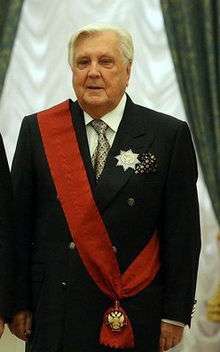Ilya Glazunov
| Ilya Sergeyevich Glazunov Илья Сергеевич Глазунов | |
|---|---|
 | |
| Born |
10 June 1930 Leningrad, Soviet Union |
| Nationality | Russian |
| Known for | painting |
| Awards |
People's Painter of the USSR People's Artist of Russia State Prize of the Russian Federation Order of Merit for the Fatherland (4th, 3rd and 2nd degree) |
Ilya Glazunov (Russian: Илья Глазунов; born June 10, 1930) is a Russian artist from Saint Petersburg. He holds the title of People's Artist of Russia, and serves as a rector at the Russian Academy of Painting, Sculpture and Architecture in Moscow (Russian: Российская академия живописи, ваяния и зодчества)
Ilya Glazunov’s paintings have mostly historic or religious themes. Famous works include Russia the Eternal, The 20th Century Mystery, The Ruining of the Temple on Easter Night, and illustrations to the works of Fyodor Dostoyevsky.
Ilya Glazunov was one of the main advocates behind the restoration of the Cathedral of Christ the Saviour (Moscow). Soviet statesman Mikhail Suslov in his later yearsn formed a close relationship with Glazunov. After a long time spent out of favour, Glazunov was given permission for a massive solo exhibition in the Manège. In the 1980s Ilya Glazunov was associated with far-right Pamyat society and became known for his nationalistic views. Awarded "For Service to the Motherland" decoration by the President Vladimir Putin.

Biography
The artist’s father was an historian named Glazunov Sergey Fedorovich. His mother's name was Glazunova Olga Konstantinovna. Ilya Glazunov survived World War II, in part because in 1942, then-eleven-year-old Ilya was transported from besieged Leningrad along the Road of Life. He stayed in the village of Greblo in the Novgorod region after his entire family perished from starvation. In 1944, he returned to Leningrad and studied in the secondary art school. From 1951 to 1957 he studied art under the direction of Professor Boris Ioganson.
In 1956, he married Nina Vinogradova-Benois. He painted the image of Nina in many of his works. Nina Aleksandrovna was a descendant of the Benois family, a familiar name art history. Her uncle was the artistic director of the La Scala Opera for 30 years. On the 24th of May 1986 Nina Vinogradova-Benois committed suicide just a few days before the opening of the exhibition of her husband in Manege.
Glazunov's success at the International competition of Young Artists in Prague prompted the opening of his first single exhibition in Moscow. Soon after in the 1960s, he traveled to Italy for the first time to paint the portrait of many famous actors and actress, among all Gina Lollobrigida and Anita Ekberg. He also painted portraits of many political leaders including Indira Gandhi, Leonid Brezhnev, Urho Kekkonen, Yury Luzhkov, Andrei Gromyko. In 1978, Glazunov started teaching in the Moscow University of Art. In 1987 he founded the Russian Academy of Painting, Sculpture and Architecture. Their children Ivan and Vera have both become artists.
- The Great Experiment. Glazunov's epic canvas on Russia in the 20th century.
Triptych “Legend of the Grand Inquisitor.”
Illustrations for F. Dostoyevsky’s novel The Brothers Karamazov.
- Grand Inquisitor. Left portion of the Triptych.
- Golgotha. Central portion of the Triptych.
- Dostoyevsky. Night. Right portion of the Triptych.
- Legend of the Grand Inquisitor, from Brothers Karamazov by Fyodor Mikhailovich Dostoevsky.
Honors
A minor planet 3616 Glazunov, discovered by Soviet astronomer Lyudmila Zhuravlyova in 1984 is named after him.[1]
- Order of Merit for the Fatherland;
- 1st class (10 June 2010) - for outstanding contribution to the development of national art, many years of creative and educational activities
- 2nd class (11 October 2005) - for outstanding achievements in the field of domestic art and education
- 3rd class (9 June 2000) - for outstanding contribution to the development of national art
- 4th class (29 May 1995) - for services to the state, achievements in work and significant contribution to strengthening friendship and cooperation between nations
- Order of the Red Banner of Labour (1985)
- People's Artist of the USSR (1980)
- Honoured Artist of the RSFSR (1973)
- State Prize of the Russian Federation (1997) - for the restoration of the Moscow Kremlin
- For his great services in the arts and arts education awarded insignia "For Service to Moscow"
- Order of St. Andrei Rublev, 1st class (Russian Orthodox Church, 4 December 2010) - account for outstanding contribution to the development of Russian art in the 80th anniversary of his birth
- Honorary member of the Historical and Patriotic Association "Russian Banner" (1989)
- Perpetual rector of the Russian Academy of Painting, Sculpture and Architecture.
- Member of the Academy of Management in Education and Culture (1997).
- "The most outstanding artist of the 20th century" in a poll of polls (1999).
- UNESCO Gold Medal for "outstanding contribution to world culture".
- Member of the Russian Academy of Arts (2000)
References
- ↑ Schmadel, Lutz D. (2003). Dictionary of Minor Planet Names (5th ed.). New York: Springer Verlag. p. 304. ISBN 3-540-00238-3.